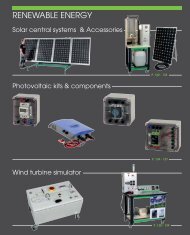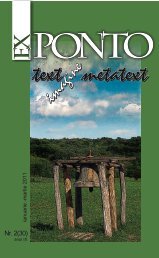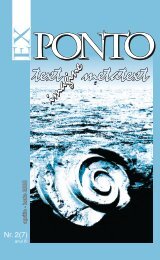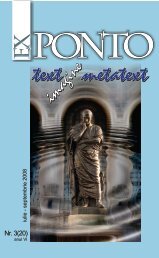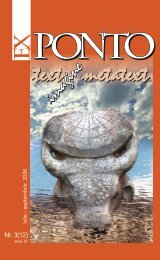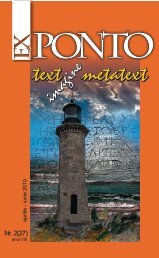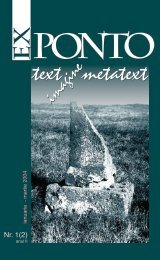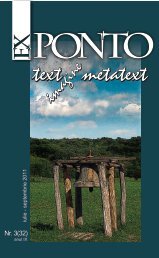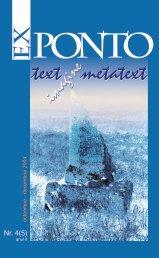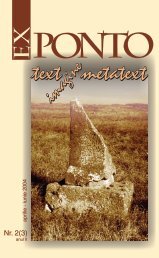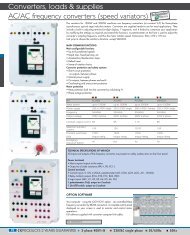Nr. 3 (24) anul VII / iulie-septembrie 2009 - ROMDIDAC
Nr. 3 (24) anul VII / iulie-septembrie 2009 - ROMDIDAC
Nr. 3 (24) anul VII / iulie-septembrie 2009 - ROMDIDAC
You also want an ePaper? Increase the reach of your titles
YUMPU automatically turns print PDFs into web optimized ePapers that Google loves.
EX PONTO NR.3, <strong>2009</strong><br />
158<br />
all distances long and unbearably dangerous, and people’s lives meaningless.<br />
The deliberate lack of focus avoids any emphasis: neither the protagonists<br />
nor the landmarks of Bucharest (Piata Universitatii, Hotel Nehoiu, Cheiul<br />
Dimbovitei, Universitatea) occupy the center of the screen. The camera<br />
suggests the complete uniformity of Romanian society and exterior space.<br />
To create the illusion of communist uniformity in the 2006 Bucharest where<br />
Mungiu shot his movie he spent long hours searching for the unremodelled<br />
blocks of flats, the best angles from where the historic buildings from downtown<br />
do not show any sign of the last two decades (graffiti, bullet holes from 1989,<br />
restoration marks, billboards). In spite of the very few anachronistic details<br />
(the 1990s’ models of trams and buses, for example) exterior scenes are<br />
authentic and identifiable as coming from the communist era.<br />
For interior scenes no sets have been built either. They were filmed in<br />
authentic Romanian apartments, hotel rooms, or dorm rooms, where there<br />
is very little space for camera placement. Thus, the camera takes a corner<br />
from where it records the static scene in which almost always one character<br />
is cornered since the best perspective offers itself naturally from the opposite<br />
corner, the one facing the camera. Since there is no room for two cameras<br />
simultaneously, Mungiu chose to have the interior scenes taken from two<br />
angles, the two opposing corners not only to induce a claustrophobic unease,<br />
but also to remain coherent with his way of presenting the event through the<br />
eyes of an objective witness, the camera itself which has no privileged place<br />
in the spatial economy of the film. The editing is simple and honest with no<br />
crosscutting, cheat cut, cut-in or cut-away. Space is crammed in between<br />
the two alternative positions of the camera which tries to cover the space<br />
exhaustively. For example, in the hotel room scene where the abortion is to be<br />
performed the two angles are from behind the two girls. It is their entrapment<br />
which is expressed by the camera. Each of them faces the other and a wall<br />
nor is there any possible escape at their back either, even though the door<br />
of the room is open, this is not an option for them. The naturalistic use of the<br />
camera accentuates the documentary aspect of the film, as well as, creates<br />
a feeling of tension, if not horror.<br />
Another element which relates the film to a documentary is the way in<br />
which the hand-held camera plays the role of the accurate informant of Otilia’s<br />
moves as if the camera were her stalker. According to Moira MacDonald, the<br />
Seattle Times film critic<br />
the camera, handheld and deceptively amateurish (heads are chopped off<br />
some shots), captures this story’s grim milieu: a shabby hotel room, with<br />
a hallway whose fluorescent light buzzes on and off; a peaceful yet eerie<br />
city street on a night that seems darker than night should be. (D4)<br />
The position of the camera is so uncomfortable and psychologically<br />
threatening that documentary characteristics are manipulated to produce the<br />
level of anxiety of a thriller in which the viewer chases Otilia in the dark streets<br />
of Bucharest, or captures what a hidden Secret Police officer might have seen<br />
and reported, the scene of bribing the hotel manager. The most difficult mission<br />
of the camera is the long and very close shot of the fetus. It is like documenting<br />
the thriller while making it; it is both metanarrative and narrative at the same<br />
time. The double-edged shot, which examines the fetus, closes the inquiry of<br />
the abortion, but it also foretells the end of the communist era.<br />
The stylistic ambiguity of the film, which might be read as a documentary,<br />
an art film, and a thriller, puts more weight on this scene since it is the only one



